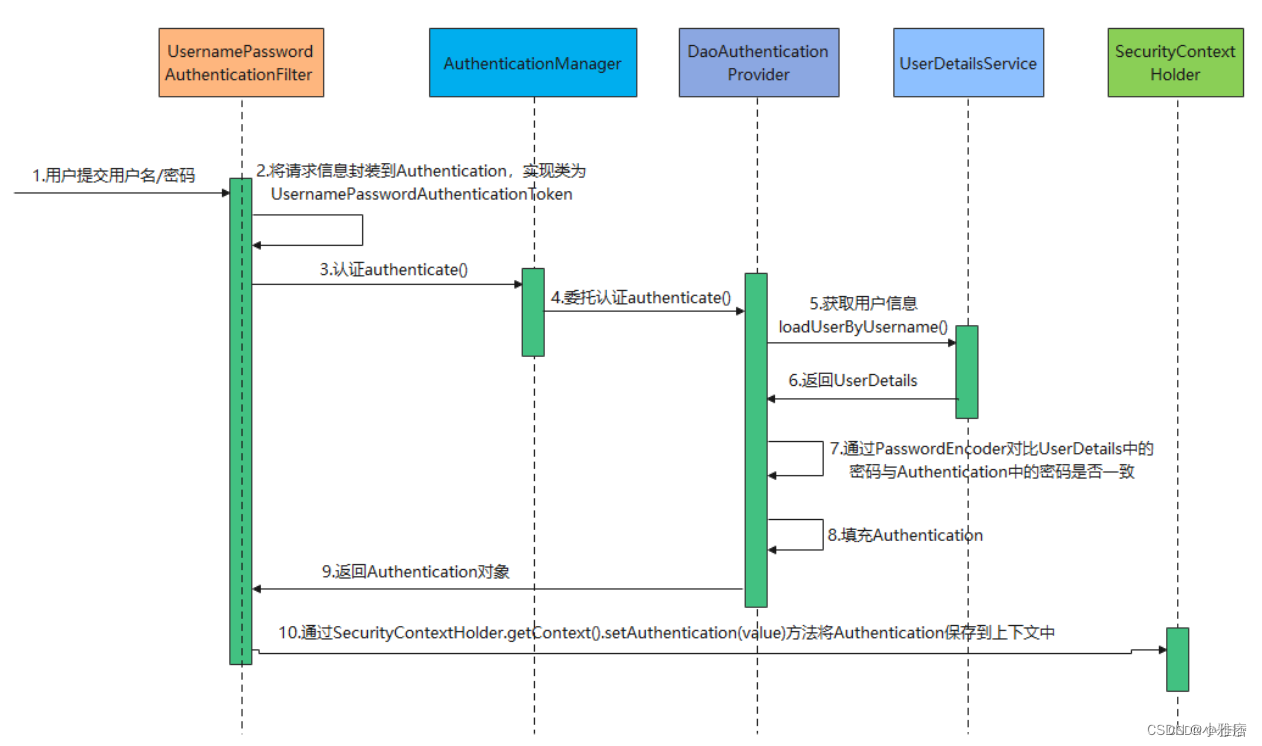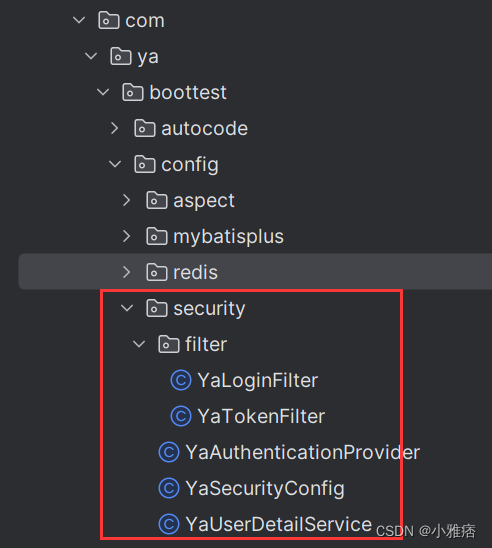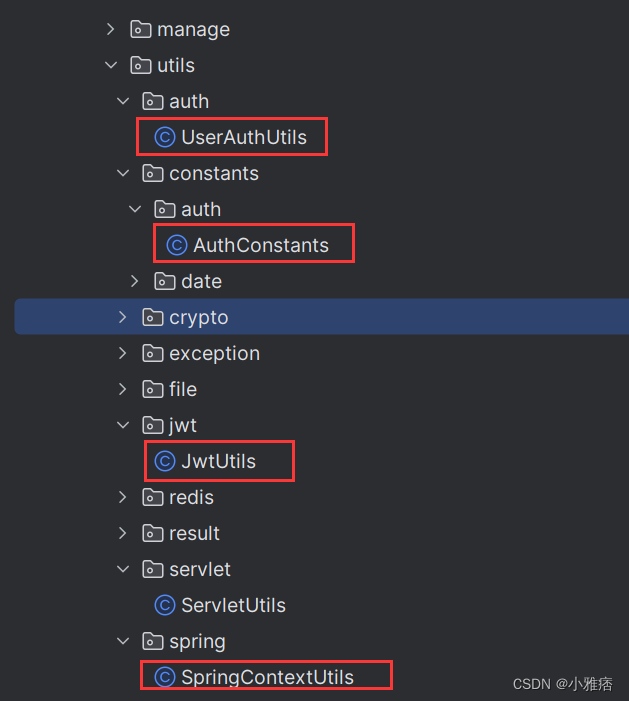- 蓝桥杯(填空题)
- 【opencv】示例-neural
- 基础的正则表达式
- CC++数据结构之链表题目答案与解析
- 【Docker系列】在 Linux 上安装 Docker Compos
- IntelliJ IDEA 2023.3 的 AI Assistant
- 【已解决】.nginx: error while loading sh
- 什么是栈,如何实现?
- SQLMap的Tamper脚本
- Jenkins简介及安装配置详解:开启持续集成之旅
- 滑动窗口最大值(力扣239)
- vue前端简单实现无缝循环滚动自动播放,滚动条上下滚动,鼠标悬停,从鼠
- Cause: org.springframework.jdbc.Can
- Spring Boot 框架
- xcode c++项目设置运行时参数
- SpringBoot 解决跨域问题的 5 种方案!
- Bilstm双向长短期神经网络多输入单输出回归分析
- Node-sass与Node.js版本对应关系的深入探讨
- 从零开始实现C++ TinyWebServer(九)---- 项目知识
- Oracle表结构转成MySQL表结构
- Mac安装及配置MySql及图形化工具MySQLworkbench安装
- Node.js 连接 mysql 数据库(Navicat)超详细!!!
- 用Python手把手教你实现一个爬虫(含前端界面)
- [架构之路-226]:信息系统建模 - 实体关系图、数据流图、数据字典
- 解决,“该设备或资源(Web 代理)未设置为接受端口“7890”上的连
- 首游南京,AI科技大事件分享:百度智能云宣布国内首家支持Llama3全
- Java实战:Spring Boot集成Swagger3
- MySQL问题解决:net start mysql80 发生系统错误
- IntelliJ IDEA 2024.1安装与激活[破解]
- 爬虫——python爬取京东商品用户评价
基于Spring Boot3实现Spring Security6 + JWT + Redis实现登录、token身份认证。
- 用户从数据库中获取。
- 使用RESTFul风格的APi进行登录。
- 使用JWT生成token。
- 使用Redis进行登录过期判断。
- 所有的工具类和数据结构在源码中都有。
系列文章指路👉
系列文章-基于SpringBoot3创建项目并配置常用的工具和一些常用的类
项目源码👉
/shijizhe/boot-test
文章目录
- 依赖版本
- 原理
- 代码结构
- security 配置
- 用户登录、注册controller,用户服务
- 用到的工具类
- 注册 AuthController.register
- 登录
- 1.登录API:AuthController.login
- 2. 登录过滤器:继承UsernamePasswordAuthenticationFilter
- 3.身份认证:实现AuthenticationProvider
- 4.从数据库中查询用户信息:实现UserDetailsService
- 5. Security配置: 使用注解@EnableWebSecurity
- token身份认证
- 1. token身份认证过滤器: OncePerRequestFilter
- UserAuthUtils
- getUserId
- 用户登出
- 实现LogoutSuccessHandler
- 修改Security配置 : YaSecurityConfig
- 下一步的计划
- 参考文章
依赖版本
- Spring Boot 3.0.6
- Spring Security 6.0.3
原理
这张图大家已经估计已经看过很多次了。

实现登录认证的过程,其实就是对上述的类按照自己的需求进行自定义扩展的过程。具体不多讲了,别的文章里讲得比我透彻。
show you my code.
代码结构
security 配置

用户登录、注册controller,用户服务

用到的工具类

注册 AuthController.register
将用户密码使用BCrypt加密存储。
@PostMapping("/register") @Operation(summary = "register", description = "用户注册") public Object register(@RequestBody @Valid UserRegisterDTO userRegisterDTO) { YaUser userById = userService.getUserById(userRegisterDTO.getUserId()); if(Objects.nonNull(userById)){ return BaseResult.fail("用户id已存在"); } try { BCryptPasswordEncoder encoder = new BCryptPasswordEncoder(); YaUser yaUser = UserRegisterMapper.INSTANCE.registerToUser(userRegisterDTO); yaUser.setUserPassword(encoder.encode(userRegisterDTO.getUserPassword())); userService.insertUser(yaUser); return BaseResult.success("用户注册成功"); }catch (Exception e){ return BaseResult.fail("用户注册过程中遇到异常:" + e); } }登录
1.登录API:AuthController.login
我们使用RESTFul风格的API来代替表单进行登录。这个接口只是提供一个Swagger调用登录接口的入口,实际逻辑由Filter控制。

2. 登录过滤器:继承UsernamePasswordAuthenticationFilter
拦截指定的登录请求,交给AuthenticationProvider处理。对Provider返回的登录结果进行处理。
- 通过指定filterProcessesUrl,指定登录接口的路径。
- 登录失败,将异常信息返回前端。
- 登录成功,通过JwtUtils生成token,放入响应header中。并将token和用户信息(json字符串)存入Redis中。
- 通过JwtUtils生成token设置为永不过期,存入Redis的token过期时间设置为30分钟,以便后边做登录过期的判断。
/** *
* 拦截登陆过滤器 *
* * @author Ya Shi * @since 2024/3/21 16:20 */ @Slf4j public class YaLoginFilter extends UsernamePasswordAuthenticationFilter { private final RedisUtils redisUtils; private final Long expiration; public YaLoginFilter(AuthenticationManager authenticationManager, RedisUtils redisUtils, Long expiration) { this.expiration = expiration; this.redisUtils = redisUtils; super.setAuthenticationManager(authenticationManager); super.setPostOnly(true); super.setFilterProcessesUrl("/auth/login"); super.setUsernameParameter("userId"); super.setPasswordParameter("userPassword"); } @SneakyThrows @Override public Authentication attemptAuthentication(HttpServletRequest request, HttpServletResponse response) throws AuthenticationException { log.info("YaLoginFilter authentication start"); // 数据是通过 RequestBody 传输 UserLoginDTO user = JSON.parseObject(request.getInputStream(), StandardCharsets.UTF_8, UserLoginDTO.class); return super.getAuthenticationManager().authenticate( new UsernamePasswordAuthenticationToken(user.getUserId(), user.getUserPassword()) ); } @Override protected void successfulAuthentication(HttpServletRequest request, HttpServletResponse response, FilterChain chain, Authentication authResult) { log.info("YaLoginFilter authentication success: {}", authResult); // 如果验证成功, 就生成Token并返回 UserDetails userDetails = (UserDetails) authResult.getPrincipal(); String userId = userDetails.getUsername(); String token = JwtUtils.generateToken(userId); response.setHeader(TOKEN_HEADER, TOKEN_PREFIX + token); // 将token存入Redis中 redisUtils.set(REDIS_KEY_AUTH_TOKEN + userId, token, expiration); log.info("YaLoginFilter authentication end"); // 将UserDetails存入redis中 redisUtils.set(REDIS_KEY_AUTH_USER_DETAIL + userId, JSON.toJSONString(userDetails), 1, TimeUnit.DAYS); ServletUtils.renderResult(response, new BaseResult<>(ResultEnum.SUCCESS.code, "登陆成功")); log.info("YaLoginFilter authentication end"); } /** * 如果 attemptAuthentication 抛出 AuthenticationException 则会调用这个方法 */ @Override protected void unsuccessfulAuthentication(HttpServletRequest request, HttpServletResponse response, AuthenticationException failed) throws IOException { log.info("YaLoginFilter authentication failed: {}", failed.getMessage()); ServletUtils.renderResult(response, new BaseResult<>(ResultEnum.FAILED_UNAUTHORIZED.code, "登陆失败:" + failed.getMessage())); }3.身份认证:实现AuthenticationProvider
调用UserDetailsService查询用户的账户、权限信息与登录接口输入的账户、密码对比。认证通过则返回用户信息。
/** *
* 自定义认证 *
* * @author Ya Shi * @since 2024/3/21 15:00 */ @Component public class YaAuthenticationProvider implements AuthenticationProvider { @Autowired YaUserDetailService userDetailService; @Autowired PasswordEncoder passwordEncoder; @Override public Authentication authenticate(Authentication authentication) throws AuthenticationException { // 获取用户输入的用户名和密码 String username = authentication.getName(); String password = authentication.getCredentials().toString(); UserDetails userDetails = userDetailService.loadUserByUsername(username); boolean matches = passwordEncoder.matches(password, userDetails.getPassword()); if(!matches){ throw new AuthenticationException("User password error."){}; } return new UsernamePasswordAuthenticationToken(userDetails, userDetails.getPassword(), userDetails.getAuthorities()); } @Override public boolean supports(Class authentication) { return UsernamePasswordAuthenticationToken.class.isAssignableFrom(authentication); } }4.从数据库中查询用户信息:实现UserDetailsService
从数据库中查询出用户的信息,供AuthenticationProvider登录认证时使用。
- 用户权限这块,目前还没用到,可以忽略。用户鉴权可能后边会单独补上。
- 为什么这里没先从Redis取用户信息?
- 如果权限或者用户信息变更这里取不到
- Redis里不建议存储用户密码。
/** *
* 继承UserDetailsService,实现自定义登陆认证 *
* * @author Ya Shi * @since 2024/3/19 11:32 */ @Service public class YaUserDetailService implements UserDetailsService { @Autowired UserService userService; @Override public UserDetails loadUserByUsername(String username) throws UsernameNotFoundException { YaUser user = userService.getUserById(username); if(Objects.isNull(user)){ throw new UsernameNotFoundException("User not Found."); } Listroles = userService.listRoleById(username); List authorities = new ArrayList<>(roles.size()); roles.forEach( role -> authorities.add(new SimpleGrantedAuthority(role.getRoleId()))); return new User(username, user.getUserPassword(), authorities); } } 5. Security配置: 使用注解@EnableWebSecurity
- 注意:Spring Security 6 配置不再继承adapterextends WebSecurityConfigurerAdapter,而是使用@EnableWebSecurity。
- YaTokenFilter是token身份认证过滤器,每次请求都会拦截,然后校验请求header中的token,这个下面会讲。
- 配置了身份认证过滤器以后,每个请求都会被拦截,即使是在过滤链中配置了permitAll(),还是会返回请求403.
- 因此,针对匿名请求、静态资源和swagger请求,在WebSecurityCustomizer中配置WebSecurity.ignoring,相当于直接绕过所有的Filter
- 针对登录和注册请求,在身份过滤器中额外配置白名单,单独放行。
- 自己学习的过程中,很多文章没有按照代码执行顺序去讲,登录和身份认证也是混着讲的,导致整个登录认证的流程理解起来有些困难。
/** *
* Spring Security 配置文件 *
* * @author Ya Shi * @since 2024/2/29 11:27 */ @Configuration @EnableWebSecurity // 开启网络安全注解 public class YaSecurityConfig { @Autowired private AuthenticationConfiguration authenticationConfiguration; @Autowired private RedisUtils redisUtils; @Value("${ya-app.auth.jwt.expiration:1800}") private Long expiration; @Bean public SecurityFilterChain securityFilterChain(HttpSecurity http) throws Exception { http // 禁用basic明文验证 .httpBasic().disable() // 禁用csrf保护 .csrf().disable() // 禁用session .sessionManagement(session -> session.sessionCreationPolicy(SessionCreationPolicy.STATELESS)) // 身份认证过滤器 .authenticationManager(authenticationManager(authenticationConfiguration)) .authenticationProvider(new YaAuthenticationProvider()) .authorizeHttpRequests(authorizeHttpRequests -> authorizeHttpRequests // 允许OPTIONS请求访问 .requestMatchers(HttpMethod.OPTIONS, "/**").permitAll() // 允许登录/注册接口访问 .requestMatchers(HttpMethod.POST, "/auth/login").permitAll() .requestMatchers(HttpMethod.POST, "/auth/register").permitAll() // 允许匿名接口访问 .requestMatchers("/anon/**").permitAll() // 允许swagger访问 .requestMatchers("/swagger-ui/**").permitAll() .requestMatchers("/doc.html/**").permitAll() .requestMatchers("/v3/api-docs/**").permitAll() .requestMatchers("/webjars/**").permitAll() .anyRequest().authenticated() ) .addFilterAt(new YaLoginFilter(authenticationManager(authenticationConfiguration), redisUtils, expiration), UsernamePasswordAuthenticationFilter.class) // 让校验Token的过滤器在身份认证过滤器之前 .addFilterBefore(new YaTokenFilter(redisUtils, expiration), YaLoginFilter.class) // 禁用默认登出页 .logout().disable(); return http.build(); } @Bean public AuthenticationManager authenticationManager(AuthenticationConfiguration config) throws Exception { return config.getAuthenticationManager(); } @Bean public WebSecurityCustomizer webSecurityCustomizer() { return (web) -> web.ignoring() .requestMatchers("/webjars/**") .requestMatchers("/swagger-ui/**", "/doc.html/**", "/v3/api-docs/**") .requestMatchers("/anon/**"); } /** * 使用BCrypt加密密码 */ @Bean public PasswordEncoder passwordEncoder() { return new BCryptPasswordEncoder(); } }token身份认证
1. token身份认证过滤器: OncePerRequestFilter
- 对于注册、登录请求,直接放行。
- 认证失败的几种情况:
- 未登录: 未携带token
- 凭证异常: 携带错误token
- 登录过期: 携带正确的token,但是token在Redis中不存在
- 账号在别处登录: 携带正确的token,但是token与Redis中的token不一致。
- token认证成功后,重新设置Redis中的token的有效时间,实现token续期。查询Redis中的用户信息,如果没有,使用UserDetailsService的服务重新查询出信息,存入缓存中。
*调用 SecurityContextHolder.getContext().setAuthentication()将用户信息存入Security上下文中,完成身份认证。
/** *
* 每次请求过滤token *
* * @author Ya Shi * @since 2024/3/21 16:52 */ @Slf4j public class YaTokenFilter extends OncePerRequestFilter { private final RedisUtils redisUtils; private final Long expiration; private static final SetWHITE_LIST = Stream.of( "/auth/register", "/auth/login" ).collect(Collectors.toSet()); public YaTokenFilter(RedisUtils redisUtils, Long expiration) { this.redisUtils = redisUtils; this.expiration = expiration; } @Override protected void doFilterInternal(HttpServletRequest request, HttpServletResponse response, FilterChain chain) throws IOException, ServletException { log.info("YaTokenFilter doFilterInternal start"); final String authorization = request.getHeader(AuthConstants.TOKEN_HEADER); log.info("YaTokenFilter ya-auth-token: {}", authorization); // 白名单 if (WHITE_LIST.contains(request.getServletPath())) { chain.doFilter(request, response); return; } // 1.请求头中没有携带token if (StrUtil.isBlank(authorization)) { ServletUtils.renderResult(response, new BaseResult<>(ResultEnum.FAILED_UNAUTHORIZED)); return; } // 携带token final String token = authorization.replace(AuthConstants.TOKEN_PREFIX, ""); String userId; // 2.提供的token异常 try { userId = JwtUtils.extractUserId(token); }catch (Exception e){ log.error("YaTokenFilter doFilterInternal 解析jwt异常:{}", e.toString()); ServletUtils.renderResult(response, new BaseResult<>(ResultEnum.FAILED_UNAUTHORIZED.code, "凭证异常")); return; } String redisToken = redisUtils.getString(AuthConstants.REDIS_KEY_AUTH_TOKEN + userId); // 3.token过期 if(StrUtil.isBlank(redisToken)){ ServletUtils.renderResult(response, new BaseResult<>(ResultEnum.FAILED_UNAUTHORIZED.code, "登录已过期,请重新登录过期。")); return; } // 4.提供的token是合法的,但是redis中的token又被使用登录功能重新刷新了一下,导致不一致。 if(!Objects.equals(redisToken, token)){ ServletUtils.renderResult(response, new BaseResult<>(ResultEnum.FAILED_UNAUTHORIZED.code, "账号在别处登陆。")); return; } // token续期 redisUtils.set(REDIS_KEY_AUTH_TOKEN + userId, token, expiration); // 获取用户信息和权限 String userDetailStr = redisUtils.getString(AuthConstants.REDIS_KEY_AUTH_USER_DETAIL + userId); UserDetails userDetails; if(Objects.isNull(userDetailStr)){ userDetails = yaUserDetailService().loadUserByUsername(userId); redisUtils.set(REDIS_KEY_AUTH_USER_DETAIL + userId, JSON.toJSONString(userDetails), 1, TimeUnit.DAYS); }else{ userDetails = initUser(userDetailStr); } SecurityContextHolder.getContext().setAuthentication( new UsernamePasswordAuthenticationToken( userDetails, userDetails.getPassword(), userDetails.getAuthorities() ) ); log.info("YaTokenFilter doFilterInternal end"); chain.doFilter(request, response); } private YaUserDetailService yaUserDetailService(){ return SpringContextUtils.getBean(YaUserDetailService.class); } private User initUser(String userJsonStr){ JSONObject userJson = JSON.parseObject(userJsonStr); String userId = userJson.getString("username"); JSONArray authArray = userJson.getJSONArray("authorities"); List authorities = new ArrayList<>(authArray.size()); for(int i=0; i< authArray.size();i++){ JSONObject authObj = authArray.getJSONObject(i); authorities.add(new SimpleGrantedAuthority(authObj.getString("authority"))); } return new User(userId, "[PROTECTED]", authorities); } } UserAuthUtils
已经登录的用户,可以从Security的上下文中获取用户的账号、基本信息、权限等。可以将其封装为工具类。因为练手的用户表较为简单,也没有部分、员工、角色、权限等概念,因此仅封装了getUserId做抛砖引玉的作用。可以根据实际使用自己封装更多的方法。
getUserId
public static String getUserId() { if (Objects.isNull(SecurityContextHolder.getContext().getAuthentication())) { return null; } UserDetails userDetails = (UserDetails) SecurityContextHolder.getContext().getAuthentication().getPrincipal(); if (Objects.isNull(userDetails)) { return null; } return userDetails.getUsername(); }用户登出
JWT本身是无状态的,但是我们后端将jwt存到redis里,相当于手动使JWT变得有状态了。那么我们在登出时就需要清空Redis中的jwt。
实现LogoutSuccessHandler
/** *
* 登出成功 *
* * @author Ya Shi * @since 2024/3/28 10:47 */ @Slf4j public class YaLogoutSuccessHandler implements LogoutSuccessHandler { private final RedisUtils redisUtils; public YaLogoutSuccessHandler(RedisUtils redisUtils) { this.redisUtils = redisUtils; } @Override public void onLogoutSuccess(HttpServletRequest request, HttpServletResponse response, Authentication authentication) throws IOException, ServletException { final String authorization = request.getHeader(AuthConstants.TOKEN_HEADER); // 1.请求头中没有携带token if (StrUtil.isBlank(authorization)) { ServletUtils.renderResult(response, BaseResult.successWithMessage("没有登录信息,无需退出")); return; } // 携带token final String token = authorization.replace(AuthConstants.TOKEN_PREFIX, ""); String userId; // 2.提供的token异常 try { userId = JwtUtils.extractUserId(token); }catch (Exception e){ log.error("YaLogoutHandler logout 解析jwt异常:{}", e.toString()); ServletUtils.renderResult(response, new BaseResult<>(ResultEnum.FAILED_UNAUTHORIZED.code, "凭证异常")); return; } // 清空Redis redisUtils.delete(REDIS_KEY_AUTH_TOKEN + userId); log.info("YaLogoutSuccessHandler onLogoutSuccess"); ServletUtils.renderResult(response, BaseResult.successWithMessage("退出登录成功")); } }修改Security配置 : YaSecurityConfig
@Bean public SecurityFilterChain securityFilterChain(HttpSecurity http) throws Exception { http ... // 前面的配置忽略 .logout().logoutUrl("/auth/logout").logoutSuccessHandler(new YaLogoutSuccessHandler(redisUtils)); return http.build(); }下一步的计划
- 用户鉴权
- 排查permitAll()失效的问题。
- 做一个练手用的用户中心,提供统一的注册、登录、认证、鉴权服务,供其他的应用调用。
- 把前期已经实现的基础的配置和工具类封装为jar包,供以后的程序使用。
参考文章
- SpringBoot3.0 + SpringSecurity6.0+JWT
- SpringSecurity (3) SpringBoot + JWT 实现身份认证和权限验证
- Spring Security 6.0(spring boot 3.0) 下认证配置流程
- SpringSecurity的PermitAll、WebSecurityCustomizer和授权
- springsecurity的http.permitall与web.ignoring的区别














